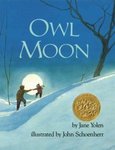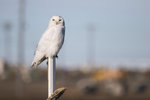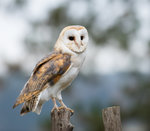


Writing about owls in a recent column reminded me of the day I met our photographer, Liam Hutcheson. It was the Olympia Christmas Bird Count five years ago. Promptly at 7:30 a.m., ten-year-old Liam was at my door, accompanied by his mother Elizabeth and his long-lens camera. Others also arrived, and we divided into count teams. Toward the late afternoon it was down to Liam, Elizabeth and me dropping in at good habitat sites hoping to chase up a few more birds for the count.
We were walking along the edge of a wooded area when Liam suggested trying a Barred Owl call. “Give it a try,” I responded, thinking to encourage the youngster. Liam issued a loud and accurate Barred Owl call. I was impressed. And I was not the only one; a nearby Barred Owl immediately responded. The smile on Liam’s face was unforgettable.
Our two large owls, Barred and Great Horned, are big birds and major predators. They therefore need and command a large hunting territory, usually living alone or in territorial pairs. They claim and defend their territory vocally with hooting, and sometimes with attacks. Liam had thrown out a challenge to the resident Barred Owl and received an immediate response. Had we stayed and continued to hoot, that owl likely would have come closer.
For entertainment during the long winter nights, we humans have been taking advantage of this territorial response for generations. This custom is commemorated wonderfully in the 1987 children’s book, Owl Moon, written by Jane Yolen. It tells the story of a young girl who is finally old enough to go out “owling” with her Pa on a full moon winter’s night. In this story, the respondent is a Great Horned Owl. It’s a beautiful book, well worth reading even if no child is nearby. Several readings with the illustrations are available on YouTube.
Barn Owl
All other Thurston County owls tend to keep a low profile compared with the Great Horned and Barred. This is because they are smaller and potential prey! They usually do not fly until it’s fully dark and seldom vocalize loudly. But they are fairly common and none more so than the Barn Owl. This is a medium-sized owl with a white oval face and body and a cinnamon and gray back and wings. Barn Owls hunt on the wing, gliding over fields and open areas, searching for small rodents. When seen flying at night, they can appear all white and “ghostly.”
They nest in cavities, and for many centuries farmers have kept the upper windows in barns open, both for ventilation and to encourage Barn Owls to take up residence as a check on the vermin that also like the barn’s shelter and food supply. The barns at the Nisqually National Wildlife Refuge have perhaps a dozen or so Barn Owls in residence, but they’re seldom seen because of their strict nocturnal habits.
Barn Owls’ nesting is not limited to barns, however. When walking along Puget Sound beaches, have you noticed cavities, some of them fairly large, in the sand and clay cliffs? Several bird species nest in these cavities and, occasionally, Barn Owls will appropriate one. No owls actually create nests; they all utilize cavities or nests created by other species.
Owls have interesting “table manners.” They swallow small prey whole and therefore, their digestive systems have to somehow deal with indigestible bones, fur, and feathers. Their gizzard does a pre-digestion separation of these parts; then they are formed into a round mass (or pellet) and regurgitated. All owls (and some other birds) do this, but Barn Owls are particularly well known for it because their pellets accumulate on the barn floor. There’s a good possibility that you have seen and handled an owl pellet since dissecting them and identifying the prey is a common school science project.
Snowy Owl
Some Nisqually Indian fishermen set their nets far out in the mouth of the Nisqually River and the unofficial mascot of these fishermen is their “White Owl.” This owl hangs out on the extreme edge of the delta, and they expect to see him every winter. When he’s missing, as he is some years, they ask me, “Where’s our owl?”
This is the Snowy Owl, a very large white owl, often with black feather tips. They breed in high arctic areas, feasting on lemmings and other prey that are active during the short arctic summer. Some breeding years there is an abundance, and many young fledge, and other summers not so much. Winter food supplies also can vary. These food variabilities influence migration and some years many Snowy Owls fly south into the northern tier of states, including Washington, seeking food.
Ornithologist’s term these cyclical high points “eruptions” and during such years we might see many Snowy Owls. These owls prefer coastal areas because flat open areas are their typical hunting grounds. But sometimes they occur away from the coast. One year I spotted a Snowy Owl out in the open turf farms along Yelm Highway southeast of Lacey. During eruption winters, it’s worthwhile to check out any white object out in an open field. It will probably be a stray plastic bag, but it might just be Snowy Owl visiting from the far north.
George Walter is environmental program manager at the Nisqually Indian Tribe’s natural resources department; he also has a 40+ year interest in bird watching. He may be reached at george@theJOLTnews.com
Photos for this column are provided by Liam Hutcheson, a 15-year-old Olympia area birder and avid photographer.
Comments
No comments on this item Please log in to comment by clicking here